Dive into the captivating realm of Phantom Poodles, where their exquisite coat patterns are just the beginning of their allure. These enigmatic canines possess a charm that goes beyond their striking appearance, captivating anyone who crosses their path. The world of Phantom Poodles is a fascinating tapestry waiting to be unraveled, revealing secrets that will pique your curiosity and leave you wanting to explore further into what makes them truly unique in the canine kingdom.
Key Takeaways
- Phantom Poodles boast distinct coat patterns with solid base colors and specific secondary markings.
- Breeding practices focus on refining Phantom markings through genetic selection and testing.
- Care and maintenance involve regular grooming, exercise, and tailored nutrition for optimal health.
- Training and socialization methods shape Phantom Poodles' behavior positively and enhance their well-being.
Phantom Poodles: An Overview
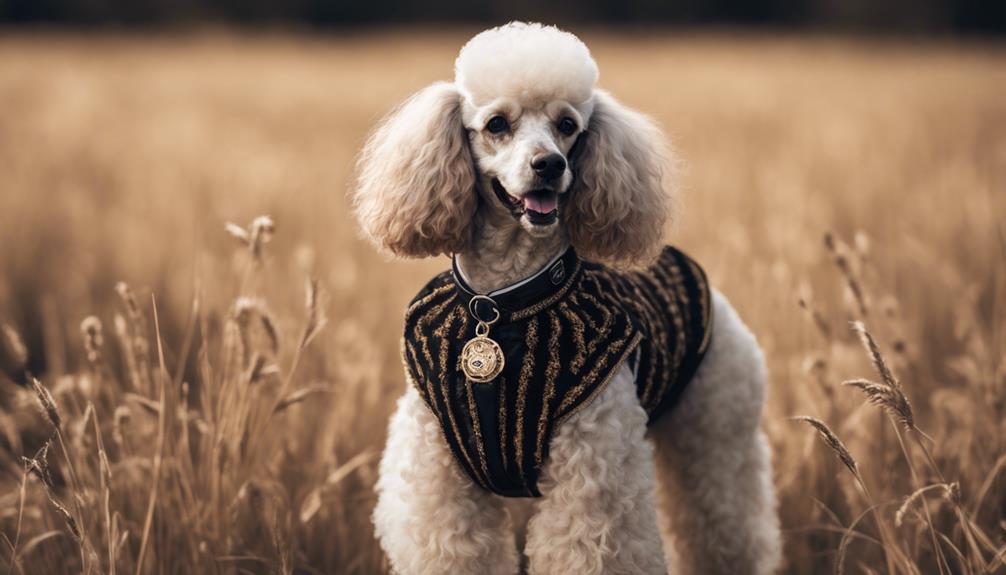
Phantom Poodles exhibit a distinct coat pattern characterized by a solid base color and specific secondary color markings on particular body parts, setting them apart as a unique breed among kennel associations like the American Kennel Club (AKC) and the United Kennel Club (UKC). This color pattern, unique to Phantom Poodles, is a defining feature that distinguishes them from other breeds. While the Standard Poodle is well-known for its single-colored coats, the Phantom Poodle showcases a striking contrast between the solid base color and the secondary markings. This secondary color typically appears on the eyebrows, muzzle, chest, legs, and beneath the tail, creating a visually appealing and distinctive look.
The color pattern of Phantom Poodles is carefully assessed in conformation shows by kennel clubs to ensure breed standards are met. This attention to detail emphasizes the significance of the Phantom Poodle's coat in defining its breed characteristics. Understanding and appreciating this unique color pattern is essential for breeders, owners, and enthusiasts who seek to preserve the integrity and beauty of the Phantom Poodle breed.
Unraveling Phantom Poodle Color Markings
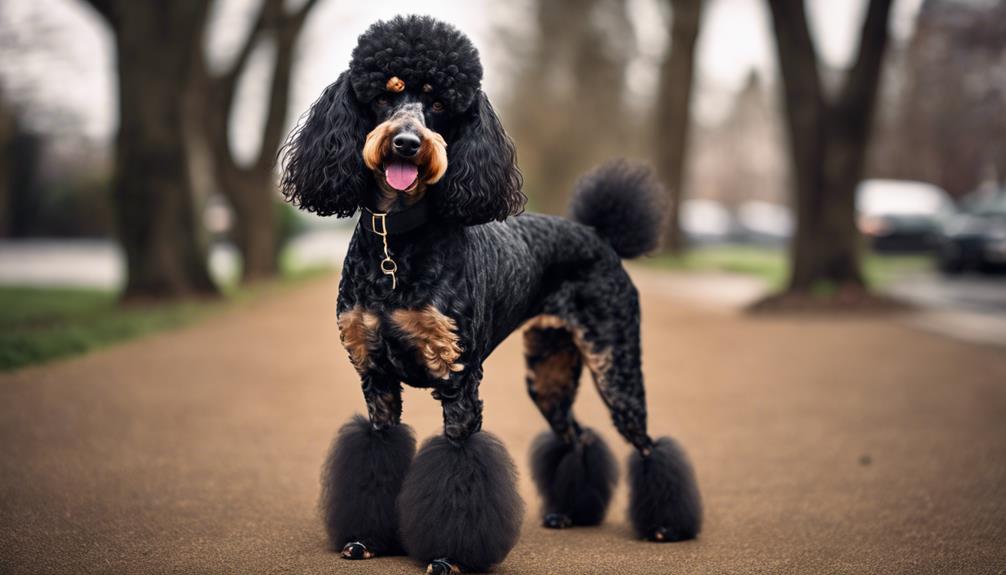
Phantom Poodle color markings result from specific genetic combinations that dictate the distribution of pigmentation. Variations in Phantom Poodle coat patterns can be attributed to the interaction of different genes responsible for color inheritance. Breeders strategically pair Poodles to enhance and refine these distinct color markings for desired outcomes in offspring.
Color Genetics Explained
Color genetics in Phantom Poodles reveal a fascinating interplay between solid base colors and specific markings on distinct body regions. The Poodle coat pattern of Phantoms involves a base color with points of another color on the legs, chest, eyebrows, and under the tail. Common combinations like black and red, silver and apricot, or black and cream contribute to their visually striking appearance. Understanding these genetics is key for predicting offspring colors in breeding. Phantom Poodles often capture attention in shows due to the striking contrast between the base color and secondary points. By delving into the intricacies of Phantom Poodle color genetics, breeders and enthusiasts can appreciate the complexity behind these unique coat patterns.
Phantom Poodle Variations
Unveiling the intricate variations in Phantom Poodle color markings offers a deeper insight into the genetic intricacies shaping their distinctive appearance. Standard Phantom Poodles display a range of color variations that must log for breeding purposes. The specific combinations of base colors and points create striking contrasts, making each Phantom Poodle unique. Here is a breakdown of some common Phantom Poodle color variations:
| Base Color | Points Color | Example Combination |
|---|---|---|
| Black | Red | Black and Red |
| Silver | Apricot | Silver and Apricot |
| Black | Cream | Black and Cream |
These combinations, meticulously controlled through breeding programs, result in the captivating coat patterns that Phantom Poodles are known for.
Breeding for Markings
Have you ever considered how specific markings on Phantom Poodles are meticulously bred for, focusing on key areas like eyebrows, legs, chest, and under the tail? Phantom Poodle owners are intrigued by the intricate process of breeding for these unique coat patterns. By selecting parent Poodles with solid color genetics and understanding inheritance patterns, breeders can consistently produce Phantom markings. Maintaining the integrity of these markings across generations is a priority in responsible breeding practices. Genetic testing plays a crucial role in identifying potential hereditary health issues and ensuring the continuation of desired coat patterns in Phantom Poodles. Through careful selection and understanding of genetics, breeders can achieve the desired Phantom markings that captivate Poodle enthusiasts.
Understanding Phantom Poodle Genetics
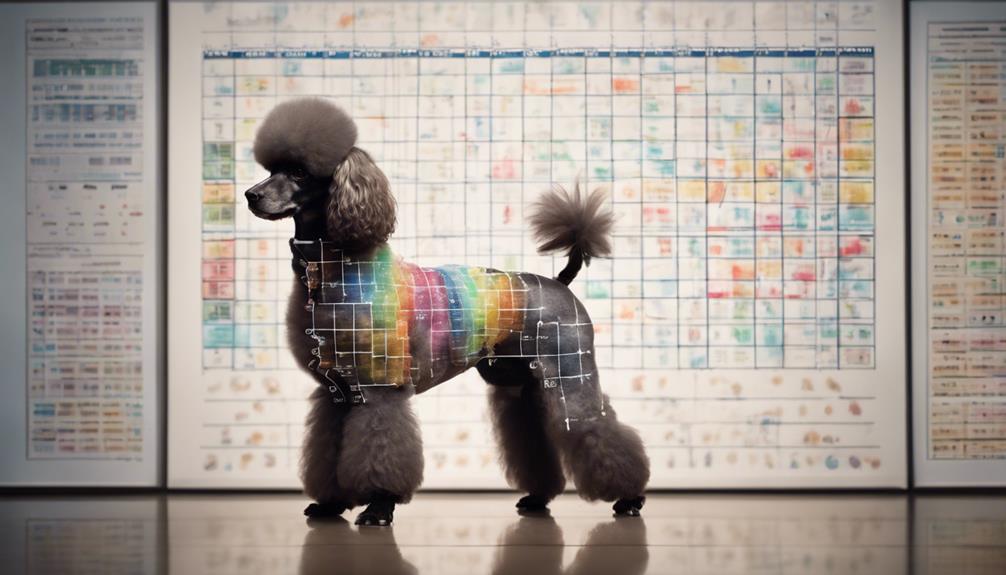
An essential aspect of comprehending Phantom Poodle genetics lies in identifying specific genes responsible for the inheritance of their unique coat pattern. The color genetics of Poodles play a crucial role in the development of the distinctive phantom coat pattern. This pattern consists of a solid base color with defined secondary markings of a different color above the eyes, on the muzzle, across the chest, under the tail, and on all four legs. Understanding the genetic mechanisms behind this phenomenon is key for breeders seeking to produce specific coat patterns in Phantom Poodles.
Size and Weight of Phantom Poodles
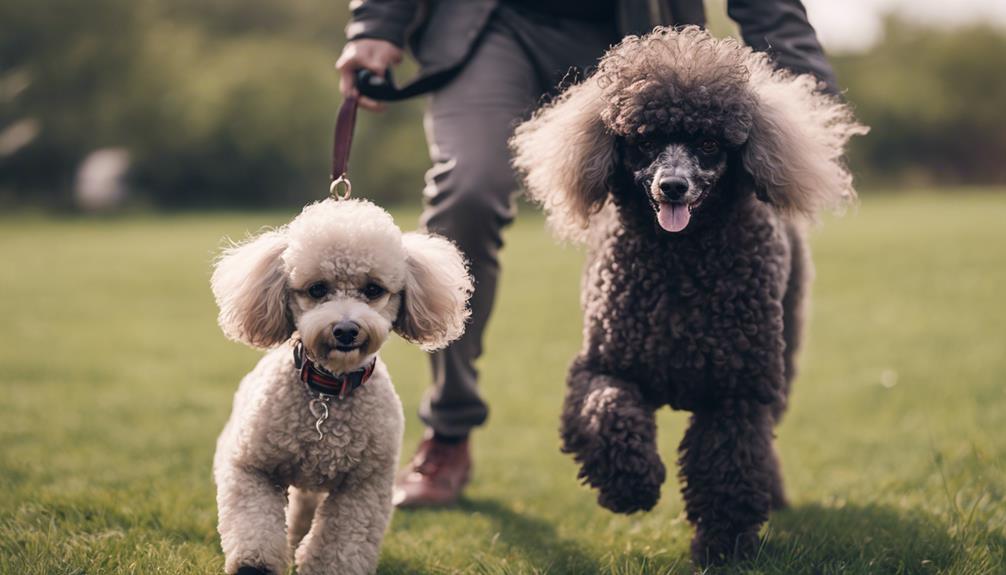
The size and weight of Phantom Poodles vary based on factors such as breed standard requirements and individual genetic makeup. Understanding these variations is crucial for selecting the right Phantom Poodle that fits your lifestyle and living space. Standard Phantom Poodles typically range from 15 to 22 inches at the shoulder and can weigh between 40 to 70 pounds, following the breed standard guidelines. On the other hand, Miniature Phantoms usually stand around 15 to 20 inches tall and weigh between 15 to 20 pounds. Toy Phantom Poodles, the smallest variant, have an average weight of 5 to 10 pounds. Below is a breakdown of the size and weight ranges for each type of Phantom Poodle:
| Phantom Poodle Variant | Size Range (inches) | Weight Range (pounds) |
|---|---|---|
| Standard | 15-22 | 40-70 |
| Miniature | 15-20 | 15-20 |
| Toy | 5-10 | 5-10 |
Delving Into Phantom Poodle Temperament
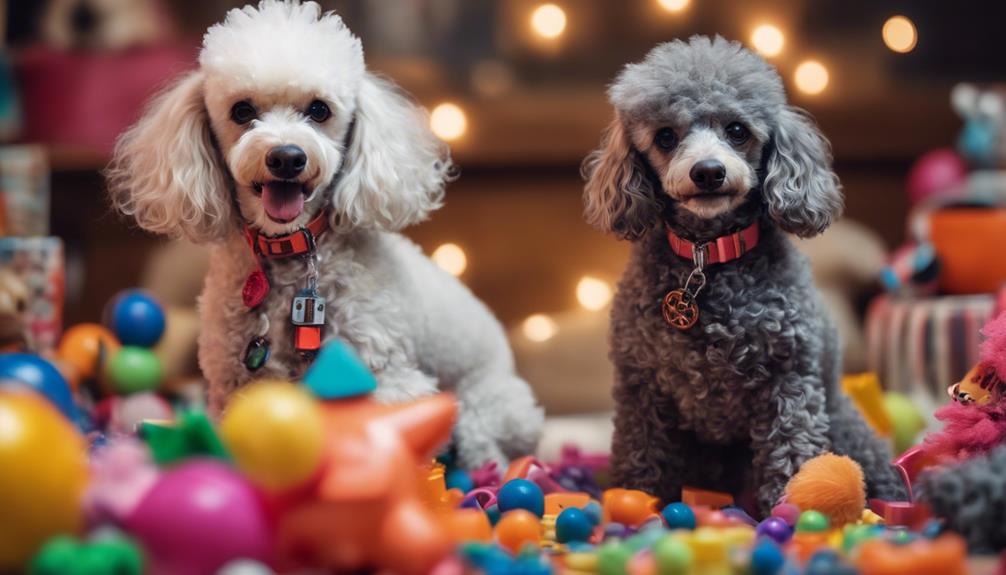
Phantom Poodles exhibit a lively and sociable demeanor, often displaying high levels of intelligence in their interactions with humans. Their friendly nature and adaptability make them well-suited for active families seeking a companion that can keep up with their lifestyle. Understanding the behavioral characteristics and temperament traits of Phantom Poodles is crucial in forming a strong bond and ensuring their overall well-being.
Temperament Traits Overview
With an intricate blend of sociability and intelligence, the temperament of the Phantom Poodle sets them apart as ideal companions for dynamic households. Training techniques and socialization methods are crucial for harnessing their intelligence and ensuring obedience. These poodles exhibit friendly behavioral traits, requiring regular exercise routines to maintain their playful and energetic nature. Bonding activities and mental stimulation play a vital role in fostering strong connections with Phantom Poodles, as they thrive on interaction and engagement. Understanding their need for both physical and mental challenges is key to a harmonious relationship with these vibrant and loyal companions. By incorporating proper training, exercise, and bonding activities, Phantom Poodles can truly shine as loving members of your household.
Behavioral Characteristics Analysis
Exploring the behavioral characteristics of Phantom Poodles reveals a fascinating insight into their dynamic temperament and social adaptability. When it comes to Phantom Poodle behavior analysis, consider the following:
- Intelligence and Trainability: Their intelligence makes training methods like positive reinforcement highly effective.
- Socialization Techniques: Early socialization is key to ensuring they develop well-rounded social skills and behavior.
- Playtime and Exercise Needs: Regular exercise and play are essential for maintaining their well-being and preventing behavioral issues.
- Mental Stimulation: Providing mental stimulation through interactive toys and activities helps prevent boredom and destructive behaviors.
Understanding these aspects of Phantom Poodle behavior can help you create a harmonious and fulfilling relationship with your furry companion.
Grooming Tips for Phantom Poodles
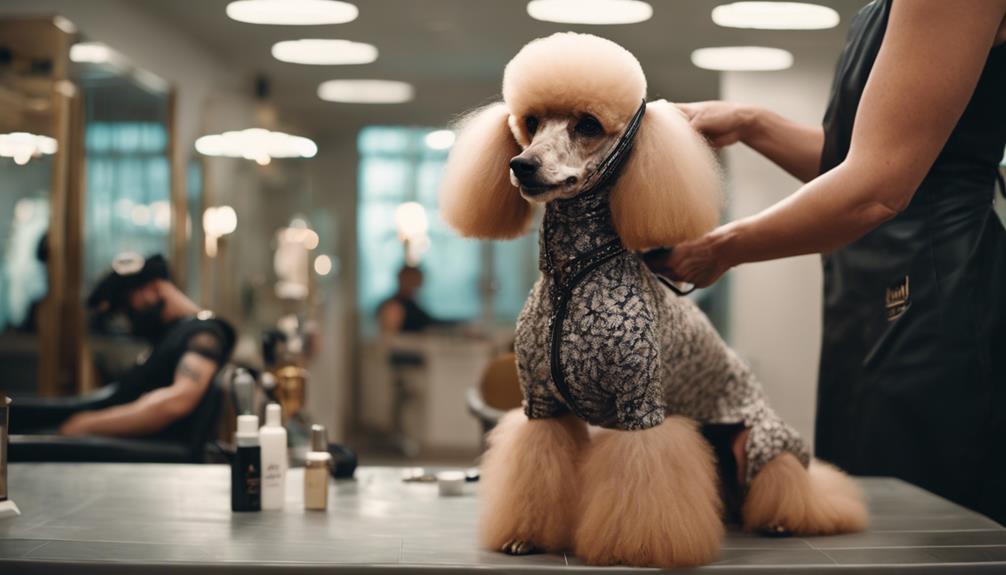
Regular brushing is essential for preventing matting and maintaining the unique coat pattern of Phantom Poodles. Professional grooming is recommended to ensure their coat looks its best. Bathing your Phantom Poodle every 4-6 weeks helps keep their coat clean and healthy. Trimming the hair around their eyes and ears is crucial to prevent irritation and maintain visibility. Additionally, regular nail trims and dental care are vital for their overall health and well-being.
When grooming your Phantom Poodle, remember to handle them gently to make the experience as pleasant as possible for your furry friend. Below is a table summarizing grooming tips for Phantom Poodles:
| Grooming Tips | Description |
|---|---|
| Regular Brushing | Prevents matting and maintains coat pattern |
| Professional Grooming | Ensures coat looks its best |
| Bathing | Every 4-6 weeks to keep coat clean and healthy |
| Trimming | Essential for eye and ear health |
| Nail Trims & Dental Care | Maintain overall health and well-being |
Exercise Needs of Phantom Poodles
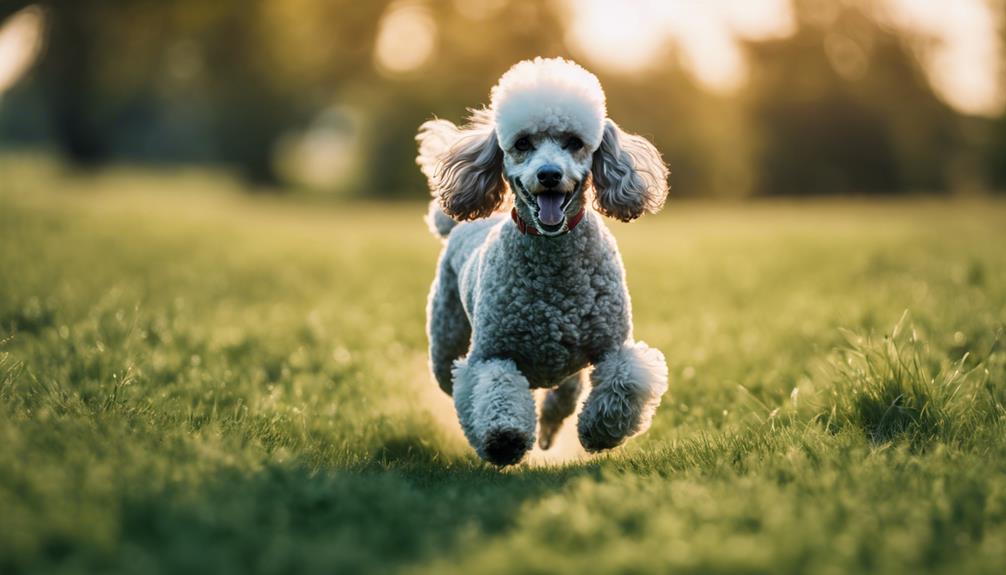
Phantom Poodles have specific exercise requirements crucial for their overall health and happiness. Daily walks, play sessions, and mentally stimulating activities are essential to keep Phantom Poodles fit and engaged. Ensuring adequate exercise not only prevents obesity but also fosters muscle strength and mental well-being in these intelligent canines.
Exercise Requirements for Phantoms
To maintain the health and happiness of Phantom Poodles, daily exercise routines are essential. Here are four ways to fulfill the exercise requirements for your Phantom Poodle:
- Outdoor Adventures: Take your Phantom Poodle on walks or to the dog park for physical workouts and fresh air.
- Mental Challenges: Engage in interactive play sessions and training activities to stimulate their minds and prevent boredom.
- Bonding Through Exercise: Spending time exercising with your Phantom Poodle strengthens your bond and enhances companionship.
- Preventing Boredom: Regular exercise helps avoid behavioral issues by keeping your Phantom Poodle mentally and physically engaged. By incorporating these activities into your routine, you can ensure a healthy and happy life for your beloved companion.
Activity Levels for Phantoms
How does the activity level of Phantom Poodles correlate with their overall well-being and behavior? Phantom Poodles are known for their high energy levels, requiring regular exercise to maintain their physical and mental health. Engaging in appropriate exercise routines not only keeps them fit but also prevents behavioral issues that may arise from pent-up energy. Providing playtime preferences such as interactive games and training sessions is crucial for meeting their exercise needs effectively. Additionally, mental stimulation benefits Phantom Poodles by keeping their intelligent minds engaged and fulfilled. Below is a table outlining the activity levels for Phantom Poodles:
| Activity Level | Description | Benefits |
|---|---|---|
| High | Energetic, requires daily exercise | Prevents behavioral issues |
| Moderate | Regular walks and playtime | Maintains physical and mental well-being |
| Low | Limited activity, may lead to boredom | Adequate exercise prevents restlessness |
Training Phantom Poodles Effectively
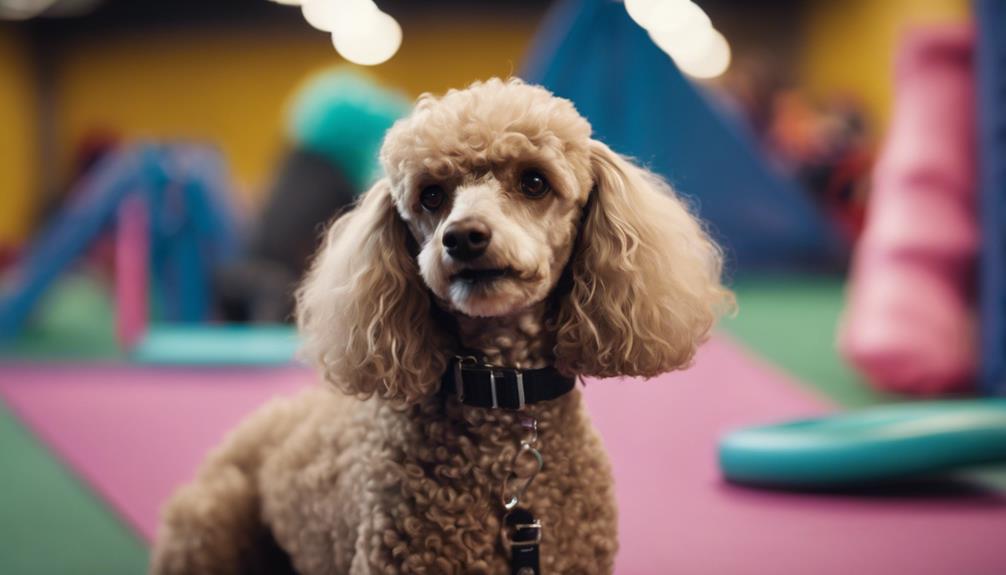
Efficiently training Phantom Poodles involves utilizing positive reinforcement methods to leverage their high intelligence and natural inclination to learn. These intelligent and eager-to-please dogs respond well to structured training routines. Here are some strategies to effectively train your Phantom Poodle:
- Advanced Training Techniques: Phantom Poodles excel in advanced training due to their high intelligence. Teaching them complex tricks and commands not only stimulates their minds but also strengthens the bond between you and your furry friend.
- Interactive Learning Games: Incorporating interactive games into training sessions keeps Phantom Poodles engaged and motivated. Games like hide and seek or fetch with a twist can make learning fun and exciting for them.
- Behavior Modification Strategies: When addressing undesirable behaviors, it's essential to use behavior modification techniques. Positive reinforcement for good behavior and redirecting negative behaviors effectively shapes their conduct.
- Consistent Rewards: Reward-based training, such as treats or praise, serves as powerful motivation for Phantom Poodles. Consistency in rewarding desired behaviors helps reinforce positive habits and encourages obedience.
Socializing Phantom Poodles
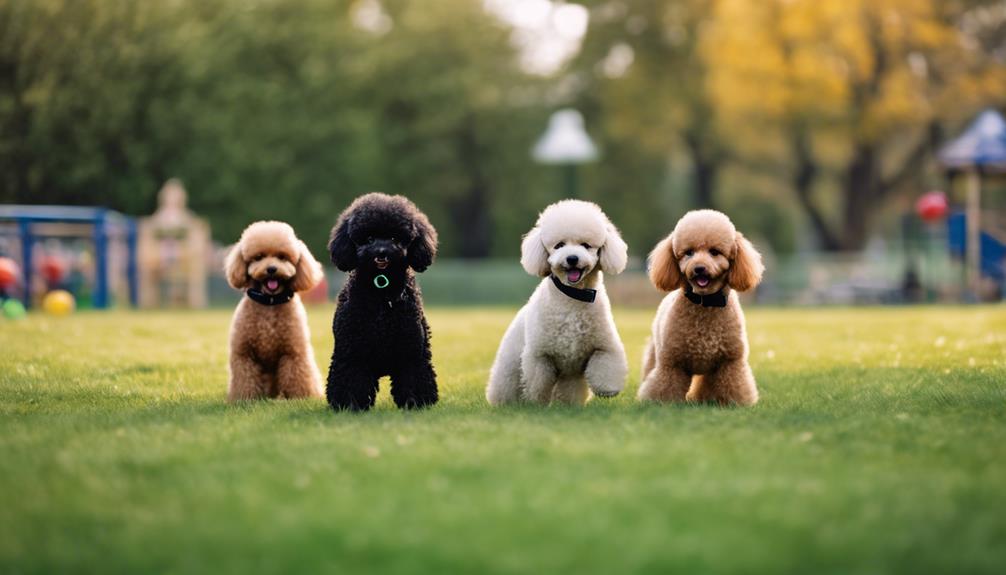
Socializing Phantom Poodles plays a crucial role in shaping their behavior and overall temperament. Puppy playdates are a great way to introduce your Phantom Poodle to new friends and environments, helping them become well-rounded companions. Training tips during socialization sessions are essential for their behavioral development. By using positive reinforcement, you can build confidence in your Phantom Poodle and help them trust new situations. Socialization techniques like introducing them to various people and places can enhance their social skills and reduce anxiety. Regular socialization with other dogs can prevent behavioral issues and encourage positive interactions. Implementing socializing strategies from a young age can make outings, visits, and interactions with strangers more enjoyable for your Phantom Poodle. Remember, the key to successful socialization is consistency and patience in building your Phantom Poodle's confidence and sociability.
Nutritional Needs of Phantom Poodles
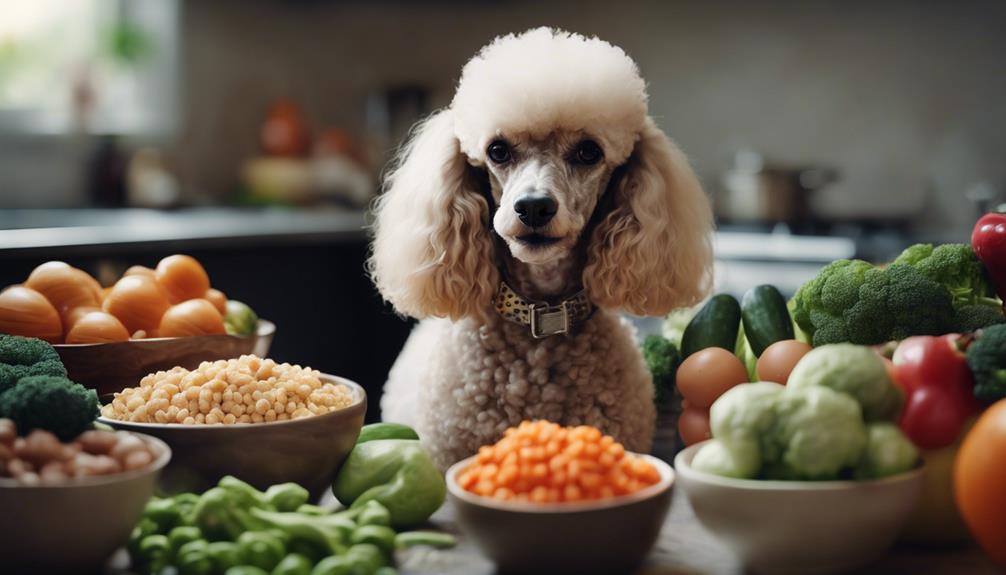
Ensuring proper nutrition is fundamental to the well-being and health of Phantom Poodles. When considering the nutritional needs of these unique dogs, there are several key aspects to keep in mind:
- Nutritional Requirements: Phantom Poodles require a balanced diet rich in high-quality protein, essential fats, vitamins, and minerals to maintain their coat health and overall well-being. Tailoring their diet to their size, age, and activity level is crucial for them to thrive and prevent weight-related issues.
- Grooming Essentials: Proper coat care is essential for Phantom Poodles to keep their distinctive phantom markings looking sharp. Regular grooming sessions to prevent matting and maintain a healthy coat are necessary.
- Training Techniques: Alongside a nutritious diet, engaging in regular exercise routines is vital for Phantom Poodles to stay fit and mentally stimulated. Training sessions can also help in strengthening the bond between you and your furry companion.
- Hydration Needs: Proper hydration is essential for Phantom Poodles to support their bodily functions. Providing access to clean water at all times is necessary to ensure their well-being and overall health.
Health Considerations for Phantom Poodles
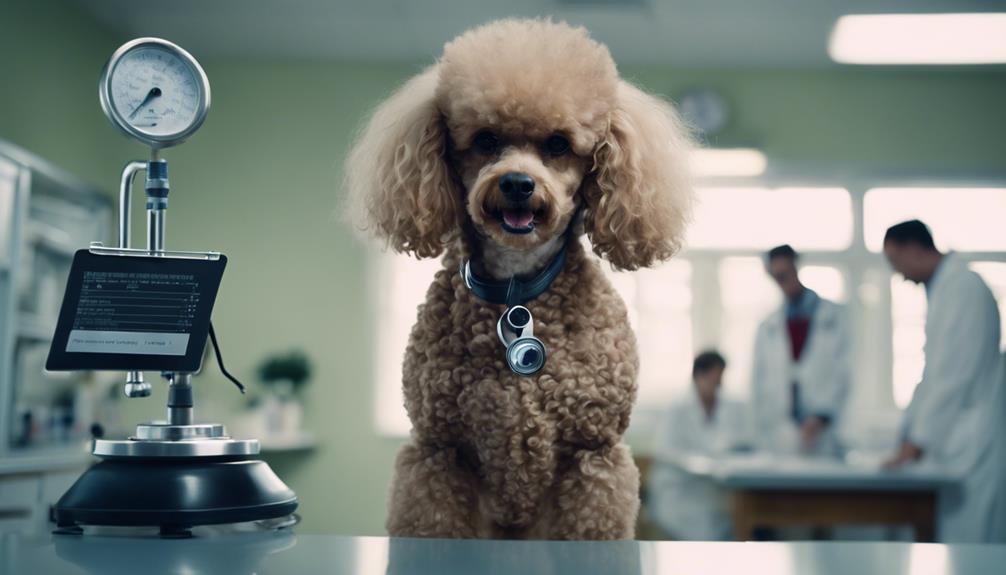
A crucial aspect in maintaining the well-being of Phantom Poodles involves understanding and addressing their specific health considerations. Phantom Poodles, like many other breeds, may be predisposed to certain health issues such as hip dysplasia, progressive retinal atrophy (PRA), and epilepsy. Regular health screenings and veterinary check-ups are essential in detecting and managing these potential concerns. Owners should prioritize a balanced diet tailored to the breed's dietary requirements, regular exercise to promote fitness, and proper grooming for overall well-being. Awareness of breed-specific health risks is crucial for proactive prevention strategies to ensure a healthy lifestyle for Phantom Poodles. Responsible breeding practices, including genetic testing, play a significant role in reducing the incidence of hereditary health conditions within the Phantom Poodle population.
| Health Screenings & Prevention | Dietary Requirements & Exercise | Hereditary Risks & Breeding Practices |
|---|---|---|
| Regular vet check-ups essential | Balanced diet crucial for health | Genetic testing helps prevent risks |
Historical Significance of Phantom Poodles
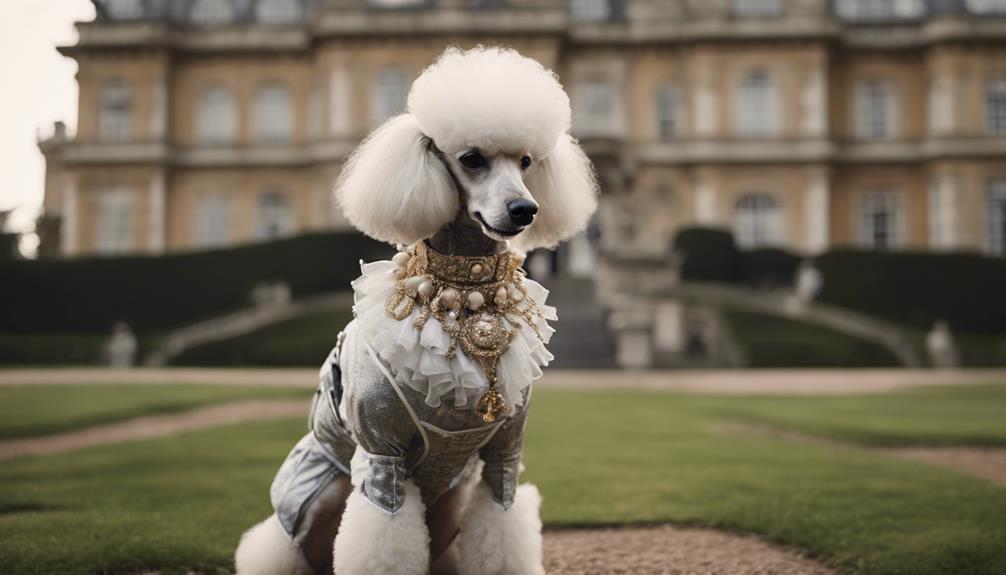
Phantom Poodles have a rich historical significance within the realm of Poodle breeding. Their unique coat color variety, once less favored for breeding, has gained popularity in recent years. The name 'Phantom' itself carries weight in the cultural impact of these distinctive Poodles.
Phantom Poodles in History
With a historical lineage rooted in the early days of Poodle breeding, the significance of Phantom Poodles has gradually emerged in the spotlight over the years. Phantom Poodles have played a pivotal role in the history of the breed, shaping its evolution and popularity resurgence in recent times. Here are four key points to consider:
- Historical origins: Phantom Poodles can trace their roots back to the early days of Poodle breeding, where their unique coat color variation started to gain attention.
- Evolution of breed: Over time, Phantom Poodles have undergone a transformation in terms of breeding standards and acceptance, moving from a lesser-known variation to a more mainstream choice.
- Popularity resurgence: Once overlooked in favor of other colors, Phantom Poodles have experienced a resurgence in popularity, becoming sought after by enthusiasts and families alike.
- Breeder accessibility: While reputable breeders for Phantom Poodles were once scarce, they are now more readily available, contributing to the increased interest in these distinctive dogs.
Cultural Impact of Phantoms
The historical significance of Phantom Poodles within the cultural landscape of the Poodle community has been increasingly acknowledged in recent years. Their presence has catalyzed a cultural evolution, shifting from a time when they were overlooked in breeding practices to now being sought after for their unique coat patterns. Over the last 15 years, Phantom Poodles have experienced a surge in breed popularity, leading to a greater appreciation for their distinctive appearance. Reputable breeders, once rare, are now more accessible as the demand for Phantoms grows. The intricate coloration of their coats plays a vital role in their cultural impact, adding to their desirability among dog enthusiasts. The name 'Phantom' holds historical significance, encapsulating the enigmatic allure that these distinctive Poodles exude.
Phantom Poodles' Influence on Other Breeds
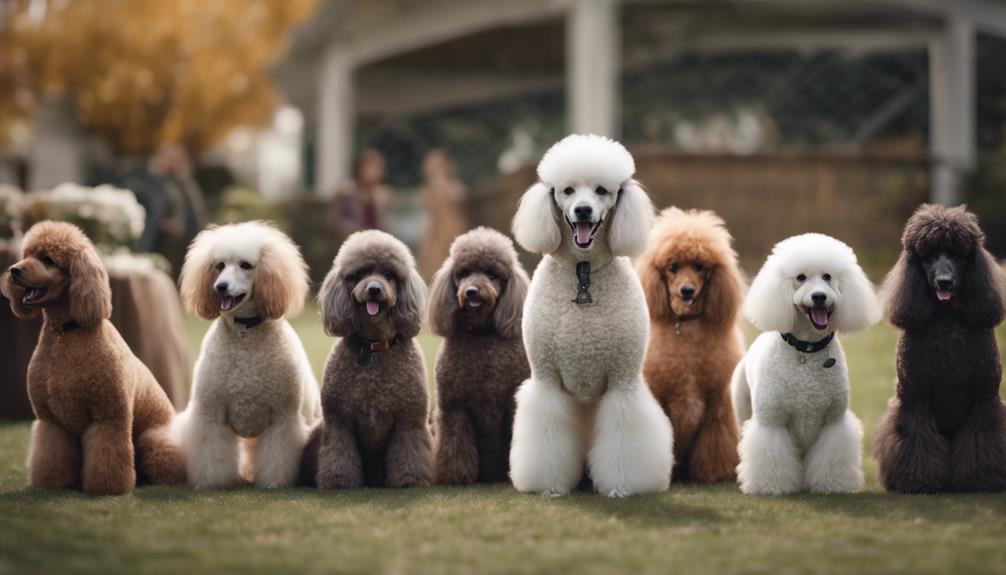
Their impact on coat patterns in related breeds underscores the significant influence Phantom Poodles have had in shaping the world of dog breeding. Phantom Poodles have left a lasting mark on the broader canine community through their distinct coat patterns and colors, influencing various aspects of breed development and breeding practices. Here are four key ways in which Phantom Poodles have influenced other breeds:
- Crossbreeding Trends: Phantom Poodles have sparked a trend in crossbreeding, with breeders seeking to incorporate their unique coat patterns into other breeds, resulting in a variety of new hybrid dogs.
- Coat Pattern Evolution: The introduction of Phantom Poodles into breeding programs has led to the evolution of coat patterns in other breeds, encouraging breeders to experiment with different color combinations and markings.
- Designer Dog Influence: Phantom Poodles' popularity as designer dogs has inspired the creation of new breeds with similar phantom patterns, emphasizing their influence on the designer dog market.
- Demand for Phantom-Like Markings: Breeders and enthusiasts alike are increasingly drawn to dogs with phantom-like markings, reflecting the growing demand for visually striking coat patterns influenced by Phantom Poodles.
Exploring the Unique World of Phantom Poodles
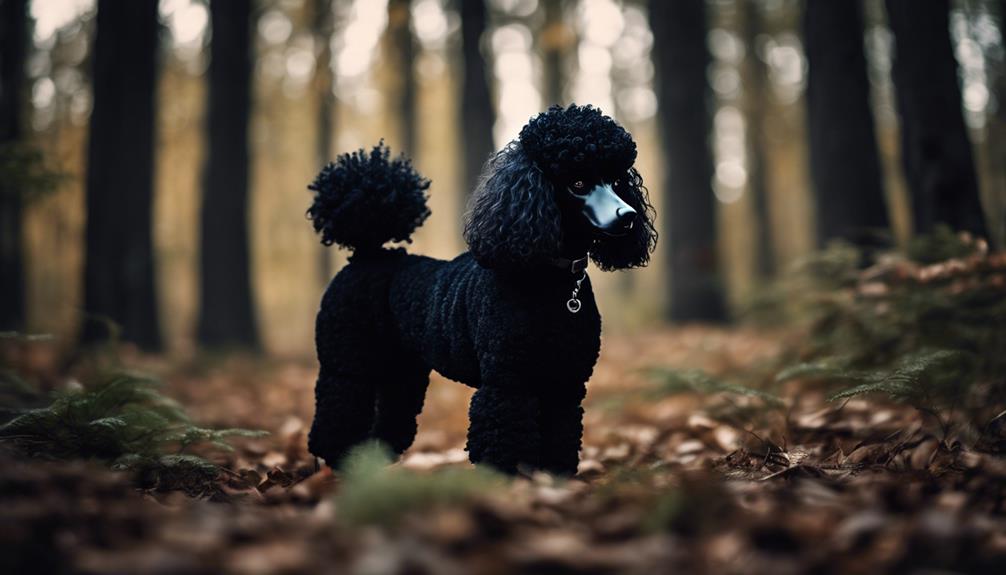
Exploring the unique characteristics and genetic intricacies of Phantom Poodles reveals a fascinating world of coat patterns and color variations that distinguish them within the realm of canine breeding. Phantom Poodles exhibit a specific coat pattern characterized by a solid base color with distinct markings on the legs, chest, eyebrows, and under the tail. These markings often come in striking combinations such as black and red, silver and apricot, and black and cream. Breeders employ meticulous breeding strategies, carefully selecting parent Poodles to produce Phantom offspring. Understanding color genetics is crucial in predicting the coat colors and patterns that will appear in the litters. The Phantom Poodles' unique beauty has garnered them a special place in the Poodle community, contributing to the diverse array of Poodle varieties. With the rising popularity of Standard Phantom Poodles, enthusiasts share their admiration for these captivating dogs through online platforms, showcasing their exceptional traits and charm.
Frequently Asked Questions
How Much Does a Phantom Poodle Cost?
Phantom poodles cost varies based on coloration popularity and breed trends. Apricot ones are pricier due to rarity, while white ones are more common and less expensive. Understanding gene factors can influence pricing between colors.
Are Phantom Poodles Rare?
Phantom Poodle colors are uncommon, varying in rarity based on location and breeder practices. Despite growing popularity among dog owners, finding reputable breeders can still be a challenge in some areas.
What Are the Characteristics of a Phantom Poodle?
Phantom Poodles possess distinct markings in secondary colors on specific body parts. Their coat colors, such as black and red or silver and apricot, create a visually striking appearance. Coupled with a playful temperament, they make delightful companions.
What Is Unusual About Poodles?
When it comes to poodles, what makes them unusual is their intricate color genetics. Understanding these genes is key when grooming or training them effectively. Dive into the science behind their coats for paw-some results!
Conclusion
You thought you knew all there was to know about dogs, but the mysterious world of Phantom Poodles has proven you wrong. These enigmatic creatures with their dual-toned coats and friendly demeanor have left you intrigued and wanting to learn more. As you delve deeper into the realm of Phantom Poodles, you realize that their unique characteristics and influence on other breeds make them truly one-of-a-kind in the canine kingdom. The world of Phantom Poodles awaits your further exploration.
